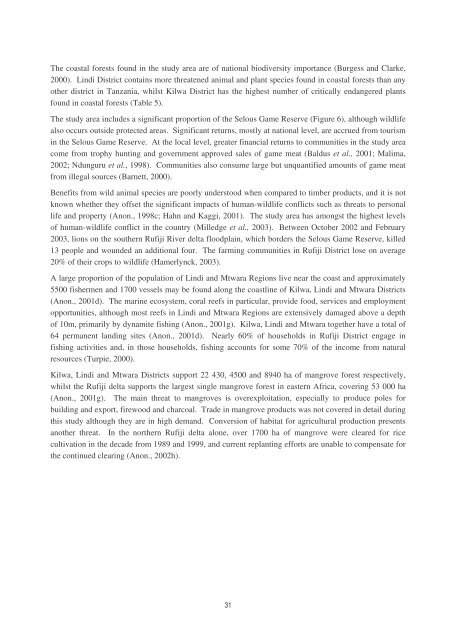Bridging the Gap: linking timber trade with infrastructural ...
Bridging the Gap: linking timber trade with infrastructural ...
Bridging the Gap: linking timber trade with infrastructural ...
You also want an ePaper? Increase the reach of your titles
YUMPU automatically turns print PDFs into web optimized ePapers that Google loves.
The coastal forests found in <strong>the</strong> study area are of national biodiversity importance (Burgess and Clarke,<br />
2000). Lindi District contains more threatened animal and plant species found in coastal forests than any<br />
o<strong>the</strong>r district in Tanzania, whilst Kilwa District has <strong>the</strong> highest number of critically endangered plants<br />
found in coastal forests (Table 5).<br />
The study area includes a significant proportion of <strong>the</strong> Selous Game Reserve (Figure 6), although wildlife<br />
also occurs outside protected areas. Significant returns, mostly at national level, are accrued from tourism<br />
in <strong>the</strong> Selous Game Reserve. At <strong>the</strong> local level, greater financial returns to communities in <strong>the</strong> study area<br />
come from trophy hunting and government approved sales of game meat (Baldus et al., 2001; Malima,<br />
2002; Ndunguru et al., 1998). Communities also consume large but unquantified amounts of game meat<br />
from illegal sources (Barnett, 2000).<br />
Benefits from wild animal species are poorly understood when compared to <strong>timber</strong> products, and it is not<br />
known whe<strong>the</strong>r <strong>the</strong>y offset <strong>the</strong> significant impacts of human-wildlife conflicts such as threats to personal<br />
life and property (Anon., 1998c; Hahn and Kaggi, 2001). The study area has amongst <strong>the</strong> highest levels<br />
of human-wildlife conflict in <strong>the</strong> country (Milledge et al., 2003). Between October 2002 and February<br />
2003, lions on <strong>the</strong> sou<strong>the</strong>rn Rufiji River delta floodplain, which borders <strong>the</strong> Selous Game Reserve, killed<br />
13 people and wounded an additional four. The farming communities in Rufiji District lose on average<br />
20% of <strong>the</strong>ir crops to wildlife (Hamerlynck, 2003).<br />
A large proportion of <strong>the</strong> population of Lindi and Mtwara Regions live near <strong>the</strong> coast and approximately<br />
5500 fishermen and 1700 vessels may be found along <strong>the</strong> coastline of Kilwa, Lindi and Mtwara Districts<br />
(Anon., 2001d). The marine ecosystem, coral reefs in particular, provide food, services and employment<br />
opportunities, although most reefs in Lindi and Mtwara Regions are extensively damaged above a depth<br />
of 10m, primarily by dynamite fishing (Anon., 2001g). Kilwa, Lindi and Mtwara toge<strong>the</strong>r have a total of<br />
64 permanent landing sites (Anon., 2001d). Nearly 60% of households in Rufiji District engage in<br />
fishing activities and, in those households, fishing accounts for some 70% of <strong>the</strong> income from natural<br />
resources (Turpie, 2000).<br />
Kilwa, Lindi and Mtwara Districts support 22 430, 4500 and 8940 ha of mangrove forest respectively,<br />
whilst <strong>the</strong> Rufiji delta supports <strong>the</strong> largest single mangrove forest in eastern Africa, covering 53 000 ha<br />
(Anon., 2001g). The main threat to mangroves is overexploitation, especially to produce poles for<br />
building and export, firewood and charcoal. Trade in mangrove products was not covered in detail during<br />
this study although <strong>the</strong>y are in high demand. Conversion of habitat for agricultural production presents<br />
ano<strong>the</strong>r threat. In <strong>the</strong> nor<strong>the</strong>rn Rufiji delta alone, over 1700 ha of mangrove were cleared for rice<br />
cultivation in <strong>the</strong> decade from 1989 and 1999, and current replanting efforts are unable to compensate for<br />
<strong>the</strong> continued clearing (Anon., 2002h).<br />
31
















